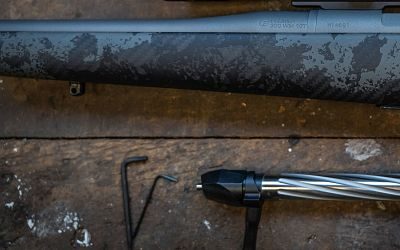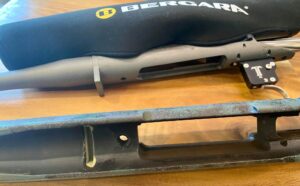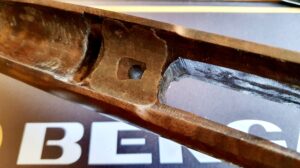Glass and Pillar Bedding a Stock

Glass and Pillar Bedding a Stock
This blog is the fourth in a series of firearm terminology we often hear in the hunting and shooting industry. I’ll go over some of these terminology listed below for each blog segment in this series for the next few months.
- Free Floating Barrel
- Muzzle Brake, Flash Suppressor
- Fluting
- Bedding
- Rifling
- Bore-Sight
- Suppressors, Moderators, Silencers, Can
Keep in mind there are so many other terms and acronym related to this industry that isn’t on here. I will highlight the most common words and discuss a few on each topic to explain what those words are and its meaning within the limits of a blog without turning it into a book.
What is Bedding?
Rifle bedding can be crucial to accuracy. The term bedding refers to the proper fitting and stability of a barreled action within the rifle stock by utilizing certain methods to provide a stable support for proper fit. If the fit and stability of the barreled-action in relationship to the stock is poor, the rifle will be inconsistent.

Bedding can reduce or eliminate any stress caused by unmatched surfaces between stock and action.
The two main types of bedding methods are pillar and glass bedding. Bedding a rifle is the method of obtaining a correct fit in the rifle’s stock, it can provides stability and improved accuracy by providing a solid fitting of stock and reduces any stress that can affect consistency within the framework of the stock during the firing process. Let’s quickly go over both methods.
Pillar Bedding: is the insertion of two hollow metal tubes that is either epoxy or resin glued in place around the front and rear action screws. These tubes, or “pillars”, act as a solid foundation for the action to prevent unnecessary movement during the firing process by eliminating or correcting inconsistent contact or alignment of the action to the stock.
Glass Bedding: is quite common in wood stocks. The epoxy resin when cured and dry acts as a sealer to the exposed wood. Glass bedding help fix any small inletting mistake by providing enough support layer to provide a snug fit and help prevent any unnecessary movements inside the stock. Also some production composite stock will sometime have too much play, by glass bedding certain areas of the stock it can help eliminate some of those fault.
Glass bedding and pillar bedding can be combine to provide the ultimate stability. Most bench and competitive shooters will rarely get one or the other done if they require bedding and will try to combine both bedding methods to provide the most stability they can get. Bedding has become a common phrase and still is to this day long before chassis style stock really became a common sight in the competitive world of rifle marksmanship. Let’s go over some of the pros and cons of a bedded rifle.
What are the Pros and Cons of Bedding?
Pros: So what are the advantages of a bedded rifle?
- Can increase consistency and accuracy by providing stability.
- Provides long-term solution if bedding increases accuracy through a proper fitting stock.
- Provides an additional layer for support for minor inletting flaws in wood and custom stock.
Cons: There are really not a lot of disadvantages that I can come up with when it comes to bedding, but there are a few. With pillar bedding, there are risks of permanently altering a stock if you lack the experience or tools to do the job correctly.
- Potential risk in permanent alteration to a stock.
- It can either help a lot, a little or not at all.
- Can cost some pretty penny if done professionally.

Glass bedding in custom wood stock can act as a support by providing a layer for improper inletting that might cause inconsistency.
If you’re thinking of bedding your own rifle yourself, do a thorough research and don’t be too quick to jump on any proposition or be influence by anyone to take on a job that you’re not familiar with, especially when it comes to pillar bedding. Weigh-in on whether the added benefits outweigh the cost of getting it done professionally.
Issues and Problem Solving
New stock can be the culprit for many shooters noticing accuracy issues right away after swapping out stock. Below are some common problems that you might want to take into consideration after switching to a new stock.
- Any noticeable movement or loose play after action is torque down to standard
- Contact of action or barrel at various point that might indicate a warp or improper inlet stock
- Potential misalignment of action screws and issues installing bottom metal
If these are some of the issues you’re having, it might be worth having a gunsmith inspect your rifle and help you decide on whether bedding will help solve the issues or help identify any issues that needs fixing to get a proper fit.
Conclusion and Question
Bedding a rifle yourself is not particularly difficult to do if you have the proper training, tools and equipment to do so. If done correctly the results from a properly bedded rifle is definitely worth the time, effort and money spent. If you have any input, questions or comments about this blog I would like to hear your feedback or experiences when it comes to bedding a rifle.
About the Author
Al Louangketh is the Bergara Rifles International Pro Team manager and Senior Editor for the Bergara Rifles International blog. He holds a PhD in Wildlife Science and is a retired U.S Army Veteran living in Germany.
Feel free to contact him for any questions you may have.
